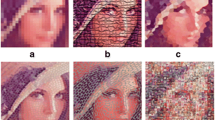Abstract
Photomosaic is an image that is composed of small images called tiles. In our work, different measurements of similarity between tiles in the desired original image and alternative tiles in the database are used in the generation of photomosaic after classifying tiles in the original image into tiles of purity and edge. And a heuristic position searching strategy is proposed to keep the original length-width ratio of each tile in the photomosaic generated unchanged if tiles in the database have different sizes.
Access this chapter
Tax calculation will be finalised at checkout
Purchases are for personal use only
Preview
Unable to display preview. Download preview PDF.
Similar content being viewed by others
References
Battiato, S., Di Blasi, G., Farinella, G.M., Gallo, G.: Digital mosaic frameworks - an overview. Computer Graphics Forum 26(4), 794–812 (2007)
Tran, N.: Generating photomosaics: an empirical study. In: Proceedings of the 1999 ACM Symposium on Applied Computing, SAC 1999, pp. 105–109. ACM, New York (1999)
Silvers, R.: Photomosaics. Henry Holt and Co., Inc., New York (1997)
Di Blasi, G., Petralia, M.: Fast photomosaic (2009)
Mat Sah, S.B., Ciesielski, V., D’Souza, D., Berry, M.: Comparison between genetic algorithm and genetic programming performance for photomosaic generation. In: Li, X., Kirley, M., Zhang, M., Green, D., Ciesielski, V., Abbass, H.A., Michalewicz, Z., Hendtlass, T., Deb, K., Tan, K.C., Branke, J., Shi, Y. (eds.) SEAL 2008. LNCS, vol. 5361, pp. 259–268. Springer, Heidelberg (2008)
Mat Sah, S.B., Ciesielski, V., D’Souza, D.: Refinement techniques for animated evolutionary photomosaics using limited tile collections. In: Di Chio, C., Brabazon, A., Di Caro, G.A., Ebner, M., Farooq, M., Fink, A., Grahl, J., Greenfield, G., Machado, P., O’Neill, M., Tarantino, E., Urquhart, N. (eds.) EvoApplications 2010, Part II. LNCS, vol. 6025, pp. 281–290. Springer, Heidelberg (2010)
Narasimhan, H., Satheesh, S.: A randomized iterative improvement algorithm for photomosaic generation. In: World Congress on Nature Biologically Inspired Computing, NaBIC 2009, pp. 777–781 (December 2009)
Tamura, H., Mori, S., Yamawaki, T.: Textural features corresponding to visual perception. IEEE Transactions on Systems, Man and Cybernetics 8(6), 460–473 (1978)
Author information
Authors and Affiliations
Editor information
Editors and Affiliations
Rights and permissions
Copyright information
© 2013 Springer-Verlag Berlin Heidelberg
About this paper
Cite this paper
Chang, D., Zhang, C., Weng, S. (2013). Methods for Photomosaic Generation Based on Different Image Similarity and Division Strategies. In: Sun, C., Fang, F., Zhou, ZH., Yang, W., Liu, ZY. (eds) Intelligence Science and Big Data Engineering. IScIDE 2013. Lecture Notes in Computer Science, vol 8261. Springer, Berlin, Heidelberg. https://doi.org/10.1007/978-3-642-42057-3_86
Download citation
DOI: https://doi.org/10.1007/978-3-642-42057-3_86
Publisher Name: Springer, Berlin, Heidelberg
Print ISBN: 978-3-642-42056-6
Online ISBN: 978-3-642-42057-3
eBook Packages: Computer ScienceComputer Science (R0)



